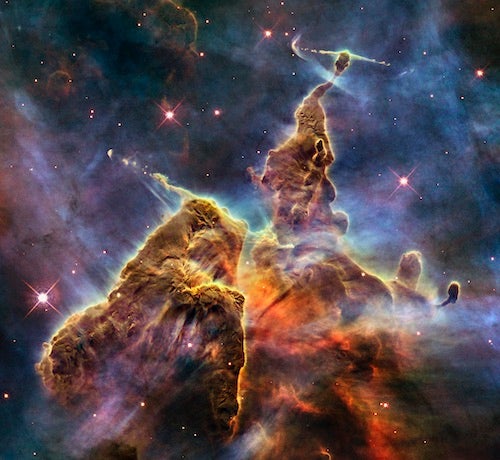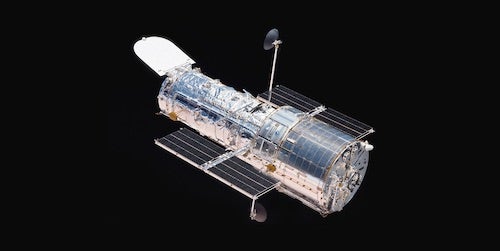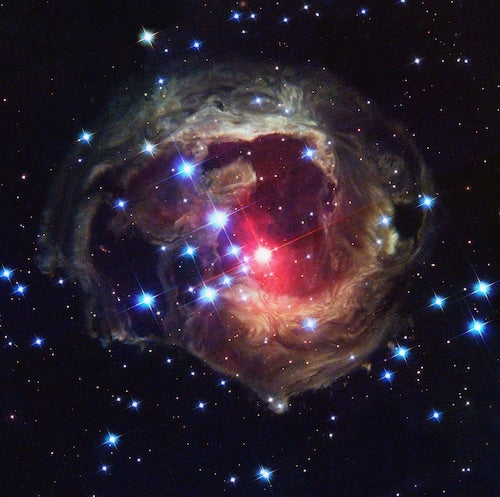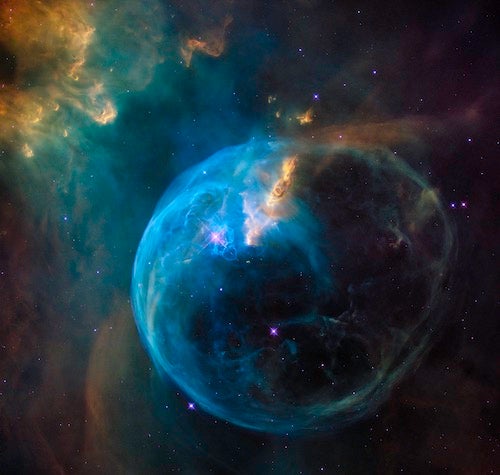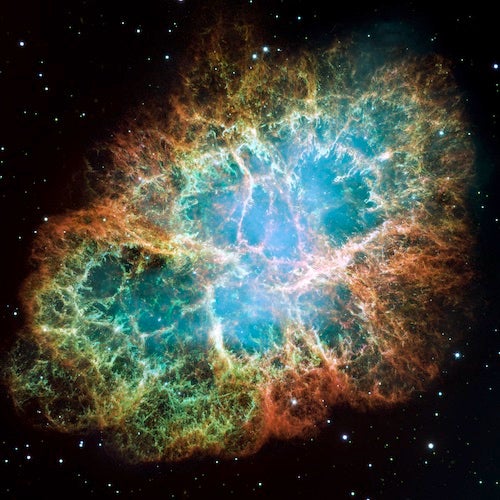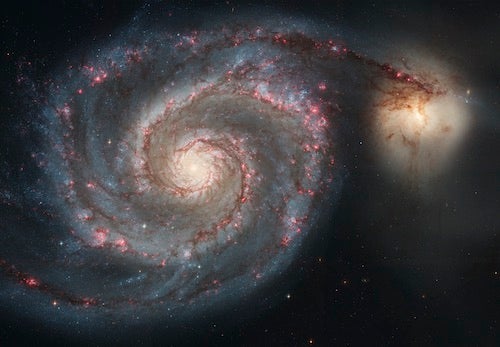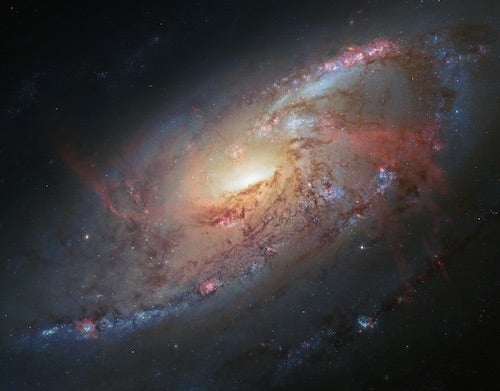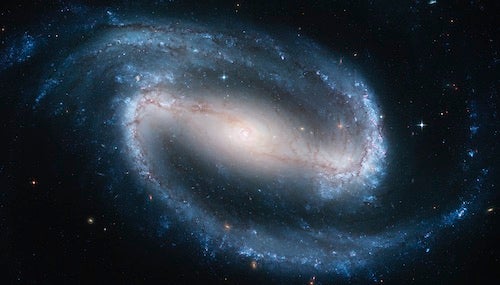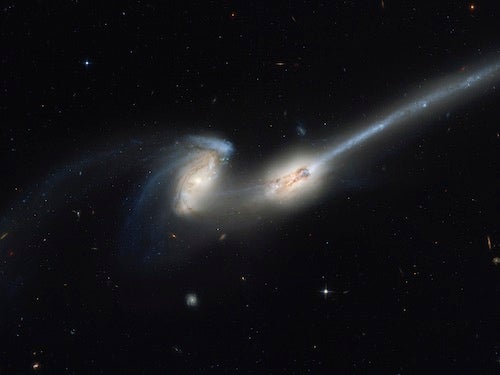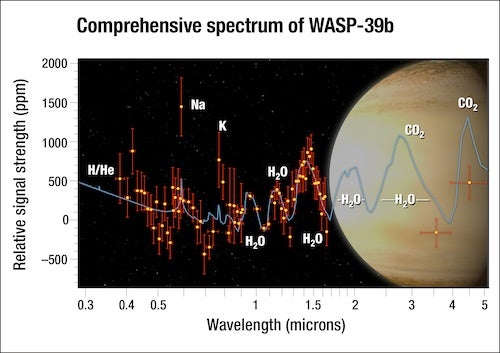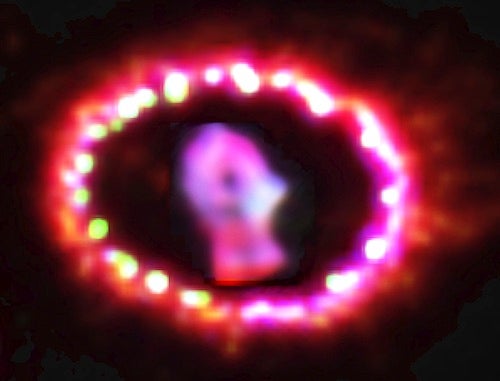Fortunately, NASA designed Hubble to be serviced regularly. On December 3, 1993, a team of seven astronauts rocketed into orbit aboard the space shuttle Endeavour. Their most important task: Install two new instruments that would serve as “eyeglasses” and transform fuzzy images into crystal clarity.
Four subsequent servicing missions — the final one in May 2009 — have completely revamped the observatory and made it into a 21st-century science machine. It has captured more than 1 million images of the cosmos, exploring objects as near as the Moon and as distant as some of the first galaxies to form in the early universe. And it has studied myriad examples of almost every type of target that lies between.
Planetary weather satellite
When people think of Hubble, most picture stunning images of Milky Way nebulae and colorful galaxies. But scientists often set their sights closer to home. No spacecraft has visited Uranus or Neptune since the 1980s, leaving Hubble and large ground-based telescopes to take up the slack. The space telescope has shown Uranus, which appeared as a bland, bluish ball when Voyager 2 flew past in 1986, to be an active world boasting bright clouds of methane. And in Neptune’s atmosphere, Hubble has tracked massive storms, some as big as Earth, propelled by winds that average 900 mph (1,450 km/h).
Hubble also has tracked storms on Jupiter and Saturn, augmenting observations made by orbiting spacecraft. And it was the space telescope that first detected evidence that water vapor may be erupting from Jupiter’s moon Europa. The plumes likely represent material from an underground ocean venting through the moon’s icy crust.
Hubble played a key role in the success of NASA’s New Horizons’ mission to Pluto. Between 2005 and 2012, the orbiting observatory discovered four new targets for New Horizons: the small moons Hydra, Nix, Kerberos, and Styx. But, more importantly, observations made over several years mapped light and dark regions on the dwarf planet’s surface. The brightest of these areas so intrigued New Horizons scientists that they targeted the flyby so it would be front and center at closest approach in July 2015. That’s how we learned so much about the heart-shaped, nitrogen-ice glacier now known as Tombaugh Regio. Hubble also discovered the Kuiper Belt object 2014 MU69, since named Arrokoth, that New Horizons flew past January 1, 2019.
Milky Way treasures
Beyond the solar system, Hubble opened a new window into star birth and star death. Raised above Earth’s obscuring atmosphere, the space telescope collects not only visible light but also ultraviolet and infrared radiation (light with wavelengths slightly shorter and longer, respectively, than what we can see). The extra information lets scientists probe deeper into the thick clouds of gas and dust that harbor young stars.
Now astronomers can observe fledgling stars in gaseous nebulae as they emerge from their birth cocoons. They can watch the hottest of these stellar youths excavate cavities in their surroundings and erode dust-filled pillars where new stars are trying to form. In the nearby Orion Nebula, Hubble revealed protoplanetary disks surrounding dozens of baby stars. These dusty disks appear to be the raw material nature uses to create planets.
When Hubble launched, scientists counted only nine planets in the universe. (This was before Pluto’s demotion to dwarf planet status in 2006.) Since the early 1990s, astronomers have discovered more than 4,000 planets orbiting other stars. Although the space telescope contributed only a handful to this total, its spectrographs have analyzed the atmospheres of several exoplanets. Perhaps most intriguingly, Hubble has detected significant amounts of water vapor on a few of these worlds.
The lives of stars play out over millions, billions, and sometimes trillions of years, and the space telescope has given astronomers front-row seats to study nearly every stage of stellar evolution. A star like the Sun will eventually puff off its outer layers, creating a glowing death shroud known as a planetary nebula. Hubble has explored dozens of these beautiful structures and found them to be far more complex than previously suspected. Instead of exhaling one dying breath, many Sun-like stars experience multiple death throes. Intricate shapes develop as newly ejected gas interacts with material from older eruptions.
Massive explosions
Not all stars are destined to die in relative peace. Stars that begin life with more than 8 or so solar masses exit this universe in violent supernova explosions. These titanic blasts seed the cosmos with heavy elements while leaving behind a highly compressed stellar core — either a neutron star or black hole. Hubble has studied the remnants of these explosions, tracing the elements ejected in the blasts and watching as their gaseous tendrils evolve slowly with time.
Perhaps most importantly, the space telescope has tracked the remnant developing around the site of Supernova 1987A, a supergiant star that exploded in the Large Magellanic Cloud (LMC) — the Milky Way’s largest satellite galaxy — in February 1987. Over the past 30 years, Hubble has witnessed the supernova’s blast wave lighting up gas ejected by its progenitor star some 20,000 years earlier, and watched as the budding supernova remnant has taken shape.
Black holes (almost) everywhere
As Hubble cast its eye deeper into the universe, it made one discovery after another. Perhaps none stirred the public’s imagination more than confirmation that black holes exist, and that they play vital roles in the evolution of galaxies. This signature achievement came in the 1990s, when Hubble examined the cores of M84 and M87, two of the largest galaxies in the nearby Virgo Cluster. This collection of thousands of galaxies lies some 50 million light-years from Earth. Using spectrographs to examine the rapid gas motions in the cores of these galaxies, the telescope revealed a supermassive black hole lurking at the center of each. Although earlier observations had hinted that black holes might exist in some galaxies, Hubble provided ironclad proof.
Of course, Hubble doesn’t restrict its gaze to the hearts of galaxies. It routinely explores individual stars known as Cepheid variables in nearby galaxies to pin down the expansion rate of the universe. Known as the Hubble constant after American astronomer Edwin Hubble, who discovered this expansion and for whom the space telescope is named, the rate plays a fundamental role in cosmology.
Cepheids serve as a critical rung on the cosmic distance ladder because the period of their pulsations tracks with their intrinsic luminosity. Observe how bright one appears in the sky and you can calculate how far away it is. Then measure how fast its host galaxy recedes from Earth and you get the expansion rate. Thirty years of Hubble observations have pinpointed the expansion rate at 73 kilometers per second per megaparsec (one megaparsec equals 3.26 million light-years). Oddly enough, measurements from the European Space Agency’s Planck satellite give a value of 67, and scientists have yet to figure out how to bridge the gap. (See “Tension at the heart of cosmology” in the June 2019 issue.)
Speaking of galaxy collisions, Hubble has verified that the Milky Way is not immune. Detailed observations of our large neighbor, the Andromeda Galaxy, show that it is on a collision course with our galaxy and will not merely pass closely. Over the next several billion years, these two behemoths will act out the same scenes now being performed by the Mice and Antennae.
It’s not surprising that galaxies collide frequently. After all, Hubble observations show that the universe holds at least 100 billion galaxies. The number comes from the study of several “deep fields” the telescope has taken by turning its cameras on small areas of apparently empty sky and exposing for days at a time. Each deep field captures thousands of galaxies, from which astronomers can estimate the universe’s total number.
To the dark side
Hubble’s sensitive detectors only pick up the light coming from celestial objects. But clever scientists have used its observations to map out the darkness that dominates our universe. Dark matter is a mysterious material that radiates no light but whose gravity serves as the glue that holds individual galaxies and galaxy clusters together. It makes up 27 percent of the mass-energy content of the universe, more than five times what the normal matter that forms stars, planets, and people contributes.

Want to learn more about pulsars and other extreme objects in our universe? Check out our free downloadable eBook: Exotic objects: Black holes pulsars, and more.
Although astronomers had seen hints that presaged many of Hubble’s notable findings, the telescope’s greatest discovery came out of the blue. Two research groups — one led by Saul Perlmutter of the University of California, Berkeley, and the other by Brian Schmidt at the Australian National University — were observing distant type Ia supernovae. These blasts occur in binary star systems in which a white dwarf pulls material from a red giant companion. When the white dwarf reaches around 1.4 solar masses, it explodes.
Because type Ia supernovae arise from nearly identical progenitor stars, their peak luminosities match. So, once astronomers see how bright the supernova appears, they can calculate its distance. The teams found that the most distant type Ia explosions were fainter than their distances implied. The only way this made sense is if some force, dubbed “dark energy,” is accelerating cosmic expansion. Planck showed that dark energy accounts for about 68 percent of the universe’s mass-energy content, a sign that our universe will expand forever at an ever-increasing rate.
Despite Hubble’s wealth of scientific accomplishments, the beauty of its images ranks among its chief legacies. Who isn’t moved at seeing stars literally come to life in the glowing gas of a nearby nebula, watching the delicate tendrils of a dying star whose path the Sun will follow one day, or viewing the dramatic spiral structure of a nearby galaxy?
Nearly every image has its own charm, no doubt because it reflects the beauty inherent in nature. And, with any luck, the hits will keep coming for many more years.

